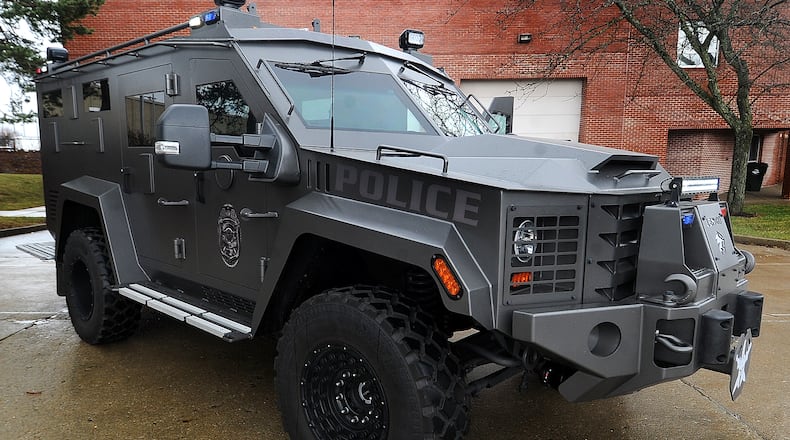The nearly 10-ton machine “will help ensure the safety of the regional SWAT team members and the citizens in the communities they serve,” according to Kettering Police Chief Chip Protsman.
MVCC members include Centerville, Germantown, Kettering, Miamisburg, Moraine, Oakwood, Springboro and West Carrollton.
Some of the communities said that “their intention” was to use American Rescue Plan Act money for their share of the cost, Weiskircher said.
West Carrollton documents show a proposal for $13,600 of its $1,347,518 in American Rescue Plan Act funds to help pay for its share. But West Carrollton was “able to use all of our ARPA funds to offset revenue losses, so no direct ARPA money as used to pay for the SWAT vehicle,” City Manager Brad Townsend said in an email.
Centerville, Kettering, Miamisburg and Springboro — the MVCC members with the largest populations — all paid their portions using non-ARPA funds, officials from those cities said.
Cost of armored vehicle
| City | Population | Contribution |
|---|---|---|
| Kettering | 57,862 | $93,254 |
| Centerville | 24,240 | $40,227 |
| Miamisburg | 19,923 | $33,744 |
| Springboro | 19,062 | $31,803 |
| West Carrollton | 13,129 | $21,853 |
| Oakwood | 9,572 | $15,196 |
| Moraine | 6,393 | $10,901 |
| Germantown | 5,796 | $9,314 |
| (Seizure funds) | $30,000 | |
| Total | 155,977 | $286,292 |
Before the vehicle’s arrival last year, the SWAT team used similar armored units owned by Dayton or either Montgomery or Greene counties, said Kettering Police Capt. Clint Price.
“The uses are sporadic for high-risk search warrants and/or critical incident response,” as well as monthly training, Price said.
He said the vehicle is used when the suspect involved in the warrant has a lengthy criminal history, including weapons charges or violent assaults or violent crimes.
“It helps us get to the scene of a criminal barricade (or) hostage rescue — things of that nature — without having to put officers in harm’s way,” Price said. “And it keeps communities safe by extracting that person, hopefully with peaceful means: Getting them to come out while we’re behind an armored structure vs. having to go in and use force,” he added. “Because without the vehicle, you have to go to the door.”
Nationally, there are a wide variety of opinions about the use of armored vehicles at the local police level.
A National Fraternal Order of Police publication said law enforcement has simply acquired modern-day equipment to meet modern-day threats, utilizing advanced tools to save lives.
The American Civil Liberties Union wrote that police are too often using more firepower than necessary, which “can dangerously escalate situations” into violence.
A paper from the libertarian Cato Institute agreed that armored vehicles can improve officer safety, while also citing an increase in SWAT raids for low- and mid-level offenses, increasing the risk of standoffs and deaths.
The vehicle bought locally, a BearCat G3, is standard use for SWAT teams and has an all-steel armor construction with “high ballistic protection,” seats 10-12 “fully equipped officers” and can accommodate off-road and rural missions, according to Lenco, its Massachusetts manufacturer.
Features include a fully-armored exterior — including windows — capable of withstanding a 50-caliber round, a turret, run-flat tires and a microphone that “is extremely loud,” Price said.
“We prefer to call them out instead of going into a structure,” he said of the microphone. “So that’s very, very good.”
About the Author

